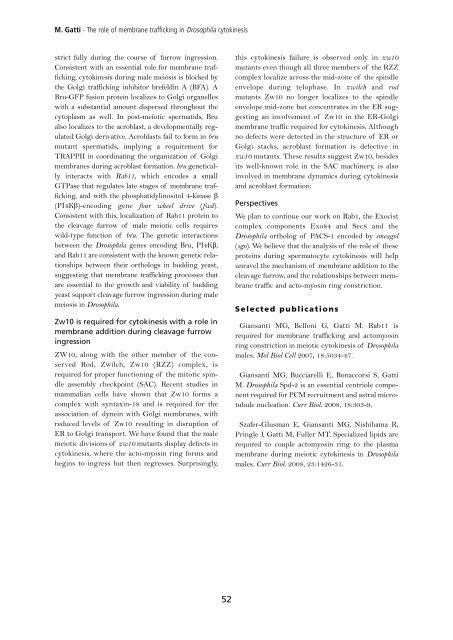download report - Istituto Pasteur
download report - Istituto Pasteur
download report - Istituto Pasteur
You also want an ePaper? Increase the reach of your titles
YUMPU automatically turns print PDFs into web optimized ePapers that Google loves.
M. Gatti - The role of membrane trafficking in Drosophila cytokinesis<br />
strict fully during the course of furrow ingression.<br />
Consistent with an essential role for membrane trafficking,<br />
cytokinesis during male meiosis is blocked by<br />
the Golgi trafficking inhibitor brefeldin A (BFA). A<br />
Bru-GFP fusion protein localizes to Golgi organelles<br />
with a substantial amount dispersed throughout the<br />
cytoplasm as well. In post-meiotic spermatids, Bru<br />
also localizes to the acroblast, a developmentally regulated<br />
Golgi derivative. Acroblasts fail to form in bru<br />
mutant spermatids, implying a requirement for<br />
TRAPPII in coordinating the organization of Golgi<br />
membranes during acroblast formation. bru genetically<br />
interacts with Rab11, which encodes a small<br />
GTPase that regulates late stages of membrane trafficking,<br />
and with the phosphatidylinositol 4-kinase β<br />
(PI4Kβ)-encoding gene four wheel drive (fwd).<br />
Consistent with this, localization of Rab11 protein to<br />
the cleavage furrow of male meiotic cells requires<br />
wild-type function of bru. The genetic interactions<br />
between the Drosophila genes encoding Bru, PI4Kβ,<br />
and Rab11 are consistent with the known genetic relationships<br />
between their orthologs in budding yeast,<br />
suggesting that membrane trafficking processes that<br />
are essential to the growth and viability of budding<br />
yeast support cleavage furrow ingression during male<br />
meiosis in Drosophila.<br />
Zw10 is required for cytokinesis with a role in<br />
membrane addition during cleavage furrow<br />
ingression<br />
ZW10, along with the other member of the conserved<br />
Rod, Zwilch, Zw10 (RZZ) complex, is<br />
required for proper functioning of the mitotic spindle<br />
assembly checkpoint (SAC). Recent studies in<br />
mammalian cells have shown that Zw10 forms a<br />
complex with syntaxin-18 and is required for the<br />
association of dynein with Golgi membranes, with<br />
reduced levels of Zw10 resulting in disruption of<br />
ER to Golgi transport. We have found that the male<br />
meiotic divisions of zw10 mutants display defects in<br />
cytokinesis, where the acto-myosin ring forms and<br />
begins to ingress but then regresses. Surprisingly,<br />
52<br />
this cytokinesis failure is observed only in zw10<br />
mutants even though all three members of the RZZ<br />
complex localize across the mid-zone of the spindle<br />
envelope during telophase. In zwilch and rod<br />
mutants Zw10 no longer localizes to the spindle<br />
envelope mid-zone but concentrates in the ER suggesting<br />
an involvement of Zw10 in the ER-Golgi<br />
membrane traffic required for cytokinesis. Although<br />
no defects were detected in the structure of ER or<br />
Golgi stacks, acroblast formation is defective in<br />
zw10 mutants. These results suggest Zw10, besides<br />
its well-known role in the SAC machinery, is also<br />
involved in membrane dynamics during cytokinesis<br />
and acroblast formation.<br />
Perspectives<br />
We plan to continue our work on Rab1, the Exocist<br />
complex components Exo84 and Sec8 and the<br />
Drosophila ortholog of PACS-1 encoded by smeagol<br />
(sgo). We believe that the analysis of the role of these<br />
proteins during spermatocyte cytokinesis will help<br />
unravel the mechanism of membrane addition to the<br />
cleavage furrow, and the relationships between membrane<br />
traffic and acto-myosin ring constriction.<br />
Selected publications<br />
Giansanti MG, Belloni G, Gatti M. Rab11 is<br />
required for membrane trafficking and actomyosin<br />
ring constriction in meiotic cytokinesis of Drosophila<br />
males. Mol Biol Cell 2007, 18:5034-47.<br />
Giansanti MG, Bucciarelli E, Bonaccorsi S, Gatti<br />
M. Drosophila Spd-2 is an essential centriole component<br />
required for PCM recruitment and astral microtubule<br />
nucleation. Curr Biol. 2008, 18:303-9.<br />
Szafer-Glusman E, Giansanti MG, Nishihama R,<br />
Pringle J, Gatti M, Fuller MT. Specialized lipids are<br />
required to couple actomyosin ring to the plasma<br />
membrane during meiotic cytokinesis in Drosophila<br />
males. Curr Biol. 2008, 23:1426-31.








